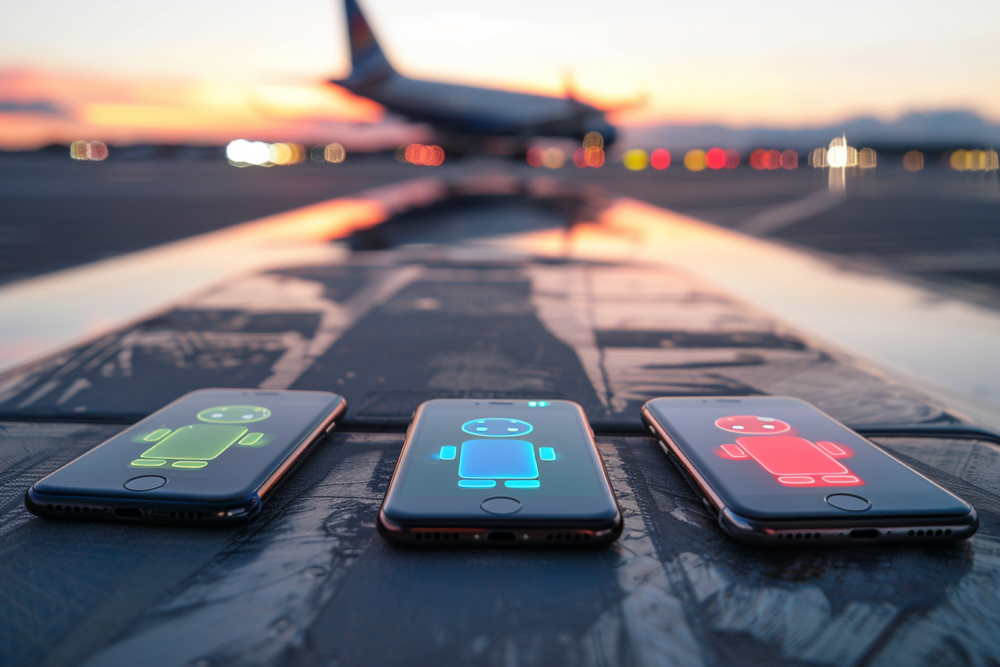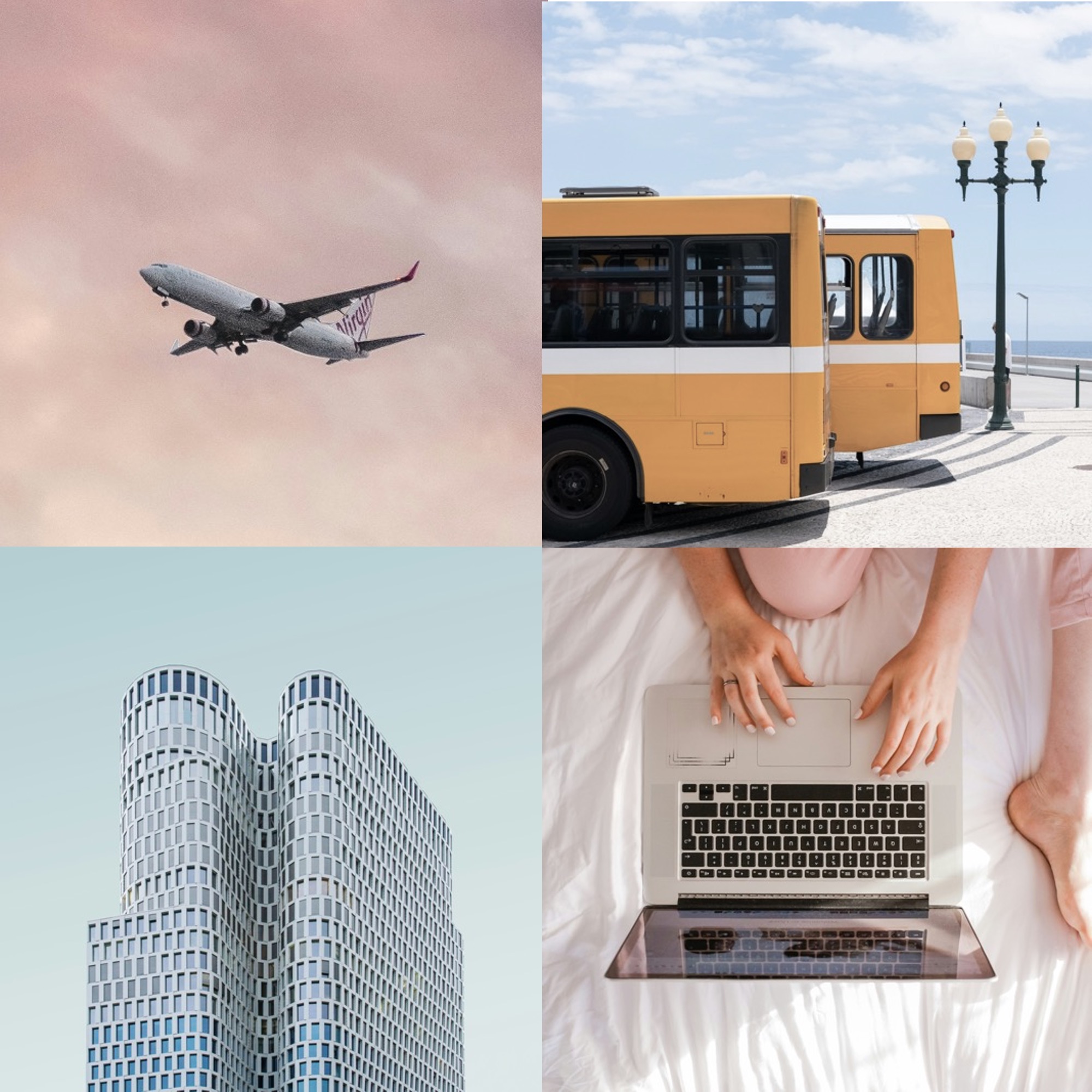When was the last time that travel – or getting around, in general – wowed you with technology?
For some of us, it was that moment when a QR code in an email opened a boarding gate at the airport for the very first time. For others, it might have been the unlocking of a shared car, bike, or scooter with a phone. Then there’s the sheer fact that you can travel from Los Angeles to Tokyo in 12 hours, which remains somehow fascinating even though widely commoditized.
Regardless of which technology impressed you back in the days, the “Roaring Twenties” of the 21st century will be holistically pivotal for transportation. Fueled by restrictions and ingenuity in the course of the Covid-19 crisis, the twenties could even be the most pivotal decade when it comes to moving people from A to B since travel first reached the masses in the mid-20th century.
While the macro and micro effects are countless and specific to the respective subsegment (e.g. inner-city transportation, rail, aviation, cruises, etc.), digitization will undoubtedly be the unifying bracket – particularly in the context of a global lockdown that’s putting extreme financial pressure on businesses and municipalities. Yet this seemingly self-explanatory factor should not be taken for granted in an industry of this magnitude, path dependency, and multidimensional interdependence.
As such, below are seven predictions by Gleb Tritus, Managing Director of Lufthansa Innovation Hub. They span the very meta to specific topics currently gathering steam.
Overview
- There’s a new normal on the go that won’t go anywhere
- Becoming greener means utilizing the existing system better
- Home improvement begins in the basement
- Standing up to your FOMO demons
- Business travel is a trillion-dollar-opportunity with the usability of 2010
- The superappization of the West starts with mobility
- Your taxi won’t fly any time soon
Travel and Mobility Tech is growing up
There are only a handful of industries impacting almost everyone on our planet, giving them practically infinite scaling potential. Travel – depending on how you slice and dice one of the overall largest sectors – is unequivocally among these mega marketplaces.
At the same time, the stage of digitization in travel and mobility, the risk appetite of its dominating incumbents, as well as the dynamics in the underlying startup ecosystems have been rather unagitated for a long time. While this had already been changing significantly before Covid-19, it is now accelerating through the need to scale up again, reinvent, and save money in post-pandemic vagabonding. With the low(er) hanging fruits of digital entrepreneurship widely harvested, founders, venture capitalists, and established corporations were finally betting big time on how people are on the move and experiencing the abroad before the recent crisis. Compared to other large industries, their ventures rely more on the support of incumbents in order to breach through regulatory constraints, legacy IT, and expensive scaling pains. As such, there’s still huge potential for this sector to form a weightier and more scalable market significance in the long run.
1. There’s a new normal on the go that probably won’t go anywhere
The majority of the world’s commercial aircraft is still grounded. Hundreds of thousands of hotels are mothballed and many borders remain closed. Covid-19 is unambiguously changing everything.
In this new reality, China utilized its digital infrastructure within weeks, from collecting personal health data via WeChat and Alipay to using ride hailers as contactless cargo carriers. While this uncompromising decisiveness – partially at the expense of data protection – is obviously not applicable worldwide, the current appetite for innovation in the face of adversity is remarkable. When it comes to the lasting effects of Covid-19 in the new decade, this is probably the most important aspect: the unprecedented crisis will accelerate the adoption of numerous technologies that were around before the outbreak. Think self-service through chatbots, real-time data on crowded focal points (e.g. airport, train stations), or contactless identification systems.
The paradigm shift triggered by Covid-19 will substantially change travel behavior throughout the world. Unnecessary travel will be increasingly substituted by video – this won’t necessarily result in a shrinking business travel market, but it will definitely add pressure to reinvent and diversify the service portfolio of asset-dependant old schoolers.
As long as the global community cannot rely on a vaccine, the term “safety” will be widely re-defined, and not only in the travel context. Hygiene will become an important differentiator in an industry once shaped by technical reliability and on-time performance. Hotels will finally introduce self-check-ins via apps beyond the sporadic PR stunts. Airlines will work with pre- and post-flight screenings depending on the route while a global digital immunity pass is in discussion. Chances are that many consequences will outlive the pandemic, just like the security measures introduced after the 9/11 attacks. Meanwhile, the whole travel chain must innovate between razor-thin margins and substantial regulatory constraints.
Digital will certainly not be able to solve every challenge, but it can contribute a lot to consumer education, reassurance, and transparency in the post-covid era. Travel and mobility carriers that manage to address the insecurities of their customers through digital channels will recover faster. As major airlines expect this recovery to take at least two-to-three years, train operators, hotel chains, and travellers around the globe will internalize new habits in researching and booking services. Simply put, the push towards digitization won’t stop even after the pandemic no longer dominates the public narrative.
The Covid-19 crisis will reshape consumer mindsets in both business and leisure travel to a degree that has been unseen since 2001.
Further reading:
- Digital technologies applied in China to combat Covid-19
- Traveler’s concerns and the measures that would make you fly again
- How the COVID-19 pandemic could change the end-to-end passenger experience forever
- Singapore shows what the new clean is with audit Initiative for hotels
- Video conferencing vs. business travel
2. Becoming greener means utilizing the existing system better
The European Union aims to cut greenhouse gas emissions by at least 40% compared to 1990s levels in this decade. Meanwhile, the world’s community is struggling to curb global warming below 2°C. Grassroots movements like “Fridays for Future,” emerging radical environmentalism (e.g. “Extinction Rebellion”), increasing societal consumption stigmas (flight shaming), and the overwhelming scientific evidence make it clear that the time to act is now – even though Covid-19 buried the intense climate debate of 2019 to temporary oblivion.
Once restarted, transportation will again be the fastest-growing contributor to the world’s climate emissions – its pre-crisis increase in energy consumption is higher than in any other consumer-oriented sector. All things considered, moving something from point A to B amounted to 23% of the global CO2 burden with light vehicles (esp. cars) and freight transportation as main drivers. If emissions from adjacent verticals (e.g. accommodation) are included, the overall footprint is even more significant and on a steady growth path. It is no surprise that governments in France, Germany, and other major economies are increasingly pushing for environmental statutes in the course of the massive bailouts of their respective airlines.
As the motor of hyperconnected economies and lifeline of cultural exchange, travel in general is a growth industry for so many good reasons. The biggest eco leverage of the underlying sectors is therefore not stigmatization, sanctions, and bans, but the fundamental redevelopment of its asset base combined with renewable energy sources – be it electrical vehicles, next-gen aircraft, or the expansion of public transportation.
The rapidly rising environmental awareness of travelers will drive their willingness to spend and consume according to their principles, making this tremendous renovation economically viable as well as inescapable down the road. However, transportation alone is a massive, asset-dependent and expensive running system with long utilization cycles. Change in the asset base naturally won’t happen within a couple of years.
In the meantime, digital innovation offers a huge, considerably untapped opportunity to get more out of the existing system while we get the new system in place.
The potential is limitless. For example, the implementation of the European Train Control System (ECTS) promises to increase overall rail capacity in Europe by up to 20%. The German Rail (Deutsche Bahn) could deploy a couple of thousand additional trains per day within the existing infrastructure. Meanwhile, the harmonization of the European aviation space (Single European Sky) could reduce its carriers’ CO2 emissions by 10% through improved routing alone. Imagine the further potential beyond that by purely data-driven optimization according to traffic, weather, and demand.
One day, when the masses are back on the streets again, overcrowded destinations like Venice or Dubrovnik will have to cap and distribute the masses throughout the day, potentially putting the responsibility on companies like GetYourGuide, Klook, and Viator.
Last but not least, digital will help sharpen the consumer mindset not only on safety attributes but also on sustainable travel: as the overall travel chain continues to get more fragmented, travelers are now in desperate need of context-sensitive digital consulting on what mode of transportation to take. Almost 50% of travelers would be willing to travel more sustainably if online booking sites offered an eco-friendly filter. While most platforms today (e.g. online travel agencies, metasearch engines) sort according to price and travel time, environmental compatibility will become another decisive dimension in the 2020s.
The 2020s will stand for ecological renovation with digital as a substantial transition vehicle.
Further reading:
- Travelers don’t walk the green talk – here is what to do
- Mapping the 50+ most relevant sustainability startups
- Carbon emissions by transport type
- Booking’s 2019 sustainable travel report
3. Home improvement begins in the basement
Conditioned by omnipresent ride-hailing convenience where tapping a phone screen summons a driver out of nowhere, the Millennials of today and major travel spenders of tomorrow are widely “uberized.”
Yet the reality of moving around remains disconnected, unpredictable, and anything but smart. One reason is that travel ecosystems (e.g. air, rail, federally-steered public transit) grew up on proprietary foundations built before the API state-of-mind. For the most part, these old dogs are unable to learn new tricks or at least talk to each other, not to mention with the new kids on the block, like micromobility. As long as this remains the case, the great promise of a seamless journey will be stuck in a perpetual cycle of meaningless nods in corporate development presentations.
Consultancies and researchers all over the world are still either talking about “travel” or “mobility” as separate playing fields. We have successfully coined the term “Travel and Mobility Tech” to promote the idea that these fields are becoming an increasingly interwoven marketplace.
Players like Omio, Duffel, the growing intermodality of Google Maps or industry-specific initiatives like NDC are giving a taste of a travel journey that is actually connected from micro- to long-haul for the very first time. Therefore, broad inventory coverage, real-time-data, and standardized interfaces will be the ingredients for travel in the connected age.
Connecting the dots of travel will be the main challenge of the new decade rather than pressing them onto fancy mobile frontends.
Further reading:
- The New Transportation Leaderboard
- Travel and Booking APIs for Online Travel and Tourism Service Providers
- Will this new airline solve the industry’s mobile-app fiasco
- An integrated perspective on the future of mobility
4. Standing up to your FOMO demons
For over 25 years, the rise of e-commerce in travel was all about making as much inventory accessible (OTAs) and comparable (metasearch) as possible. Now, with most of it at our fingertips, we are drowning in opportunity, variety, and anxiety over dynamic pricing.
This increasing complexity of the digital age won’t recede but demand a more frictionless and tailored delivery of already existing products and services. Not content, but context, curation, and consolidation will be king in the 2020s.
Meanwhile, the conformism coming along with the streamlined travel of “Generation TripAdvisor” will further fuel the anti-trend of highly individualized travel (think Long Tail theory) that again must be delivered in an individually relevant manner to be commercially viable.
Some great examples of this include new entrants like Tourlane, which is on a path to offer professionally tailored travel experiences on a scalable business model, or Hopper (of which we are a proud investor), a mobile-only OTA that informs travelers when it’s time to book a flight – and freezes the fare for a fee if they’re still undecided.
In the meantime, expect the rebirth of travel-related insurance addressing all your FOMO, the rise of digital assistance tailored to travel use cases, as well as booking platforms with highly curated inventory like HotelTonight in its early days.
Decreasing the degree of uncertainty is now more important than increasing the degree of variety.
Further reading:
- Catching travel by the long tail
- Undertourism is the new overtourism
- Too many people want to travel
- How are companies really facing personalization in the travel industry
5. Business travel is a trillion-dollar-opportunity with the usability of 2010
Over the past decade, ride-hailing giants (Uber, Lyft), micromobility newcomers (Bird, Lime), and lodging disruptors (Airbnb, Oyo) have all grown to become billion-dollar strongholds on mostly private consumption. Yet modern user interfaces and mobile services somehow seem unable to penetrate the invisible barrier surrounding all things business travel.
It took a historic global crisis to finally manifest video conferencing in the B2B context. Now, the question is how this accelerant will affect other aspects of doing business over long distances. In recent years, most of the neat digital improvements along the travel chain were tailored towards private individuals, widely ignoring the work part of their life. We are conditioned as private travelers on the weekends but must then deal with monolithic travel management systems, call centers, and travel expense battlefields on weekdays. It’s like going back and forth in time.
Although business and pleasure are increasingly coalescing, the needs of professional road warriors remain distinct – think expense management, rebooking flexibility, travel rule compliance and, now more than ever, enhancement through video conferencing. How can we tie these things together digitally in a global market volume valued at $1.7 trillion by 2023 prior to the Covid-19 outbreak? It is too early to say whether the market for business travel will stagnate or even shrink in the long term as a result of the Coronavirus shock. What is certain is that its structure and nature will change permanently, especially in technological terms.
Depending on the market, up to 50% of all business travel volume remains unmanaged, which means that high-volume B2B customers must organize their professional travels just like we browse vacation options on a Sunday afternoon.
Heavily funded spearheads like TripActions (we are an investor), Lola, and Travelperk, as well as evermore local movers and shakers like Comtravo (Germany) and Travelstop (Singapore) have been pushing travel management into the reality of modern times until recently. Now, slowed down significantly by the pandemic, the innovation dynamic has come to a temporary standstill, but is expected to rebound with the overall business travel market by the end of 2020. Overall, given the size of opportunity, the number of predominant digital-first players in this segment remains surprisingly low. And again, the virus will act as a digitization accelerator in this regard.
Aside from organizing, booking and processing business trips, there’s a ton of specific use cases like expense management, duty of care, or travel for guests and applicants – way more than a mere niche when looking at it globally. Therefore, once we recover from the recent shockwave, we can expect a substantial founding and funding dynamic around B2B travel startups in the new decade.
The value delivery in booking and managing private trips will finally reach your day-to-day work realities.
Further reading:
- Business travel startups are transforming the industry
- How modern companies are disrupting business travel
- The start-ups trying to shake-up corporate travel
- New Report: The state of business travel 2020
- Travelstop counts on Asian startups to unlock new era in corporate travel
6. The superappization of the west starts with mobility
The first generation of so-called super apps – digital Swiss Army knives covering a variety of everyday use cases from payment to groceries – started out in Asia and was built on the most unifying use case of all, communication. Take WeChat (China), Kakao (Korea), or Line (Japan, Thailand, Taiwan).
The second generation – still Asian – is currently building on mobility first and foremost, like Didi Chuxing (China), Grab (Singapore), Go-Jek (Indonesia), and Ola (India).
As a result of the aforementioned complexity on the go, home screens will shrink in terms of top-of-mind-applications – a good time for consolidating powerhouse applications to finally arrive in the West, although we most probably won’t call them super apps and they will arise from a different market dynamic than in Asia. As we leapfrog the instant messaging stage, mobility should be the entry point into daily relevance, currently making Uber and Google Maps the biggest prospects for Western super apps of global appeal.
There are also many local champions of high day-to-day engagement like the DB Navigator, a surprisingly underutilized app from the German Railway covering most of the public transit in the country for nine million monthly active users.
At the end of the day, adjacent value pools beyond mere mobility – a highly effective, but inevitably loss-making app engagement driver – appear to be the only way for public-market-pressured ride hailers to turn a profit long before the promised land of autonomous driving.
Look forward to your personal “WeChat moment” outside Asia.
Further reading:
- The next Super App will come from Travel and Mobility Tech
- Amazon confirms flight-booking launch as part of a Superapp strategy
- Google’s playbook to become a Super App in travel
- Where travel brand loyalty sits in a super app world
- Google Maps is ready to transform the world Superapps
- Uber’s quest to become the west’s first super-app
7. Your taxi won’t fly any time soon
The VTOL craze has become mainstream in a mix of capital influx (Volocopter, Lilium, Joby Aviation) and human imagination turning up. Major press outlets and top-tier consultancies all over the world have been fantasizing about a Blade Runner-esque future of individual air transportation, in many cases shifting from initial skepticism to hasty praise and back again.
Indeed, the narrative of “moving up” is as obvious as it is fascinating: metropolitan population, traffic congestion, and pressure on transportation emissions are on the rise while electric aircraft that can hover, take off, and land vertically become technologically feasible.
Building a certifiable batch capable of manned – and piloted – aerial transportation on batteries is one thing happening in the 2020s. However, forming the regulatory framework, shaping air traffic control, training thousands of pilots for the pre-autonomous era, and installing landing infrastructure in densely populated areas of democratic states cannot fly to the tune of VC-oriented business plans – even in the post-covid new normal.
And then there’s this underestimated uncertainty of convincing people to board early-stage aircraft with a couple of strangers in a confined space.
At least in the Western hemisphere, the current conglomerate of challenges is too big, even with huge leaps in adaptation. Still, unmanned VTOLs lifting cargo in zoned areas appears to be very feasible. We may also see some manned VTOL transportation over unpopulated areas in disruptively thinking jurisdictions like the United Arab Emirates, China, and Singapore in the course of specific test cases.
We won’t see air taxis regularly transporting people over New York, Berlin, or Sydney in the 2020s.
Further reading:
- The air taxi hype is real. Time to focus on regulation
- Air-mobility solutions: What they’ll need to take off
- Flying-cab drivers wanted
- Why Porsche and Toyota Are Investing in Flying Cars
- Flying cars: separating hype from real potential
- Urban air mobility: How “a whole new form of flight” will shape the cities of the future
A call for optimism
Despite the substantial shakeup of Covid-19 that will slow down travel and mobility for at least two years, there are still exciting times ahead when it comes to moving around in the new decade. As a result of the pandemic, the sector is on an even faster path towards reinvention. Transportation will become smoother, more flexible, and efficient in so many dimensions, widely contributing to its essential core of connecting people, cultures, and economies once the world reaches its new normal.
But how far away is this new normal? For now, the only certainty is that there is none. In other crises, such as 9/11 or the global economic crisis of 2007, travel and mobility segments recuperated faster than originally forecasted. Today, we are living in different, even faster times. The robustness of the traveller and their desire for getting around should therefore be expected as a matter of principle, giving travel providers a lot of ammunition to innovate once back on track.
Still, all of the above predictions have yet to occur. Major travel and mobility platforms (be it air, land, sea, short- or long-haul, lower or upper-end of the market) have been on an inevitable growth path across the globe for many years and have reached the edges of the possible in many markets. The need to handle never-before-seen masses, paired with the consequences of the Coronavirus, provides a massive leeway to utilize substantial (digital) innovation, both in the public and private sectors.
Yes, it will be a transformational journey. En route, you’ll be sure to have your “aha” moments just as that day you used the QR code at the airport for the first time.
Disclaimer: The views expressed in this article are those of the individual author and are not the views of the Lufthansa Innovation Hub, the Lufthansa Group, or any of its affiliates. Certain information contained here has been obtained from third-party sources. While taken from sources believed to be reliable, the Lufthansa Innovation Hub has not independently verified such information and makes no representations about the enduring accuracy of the information or its appropriateness for a given situation.















